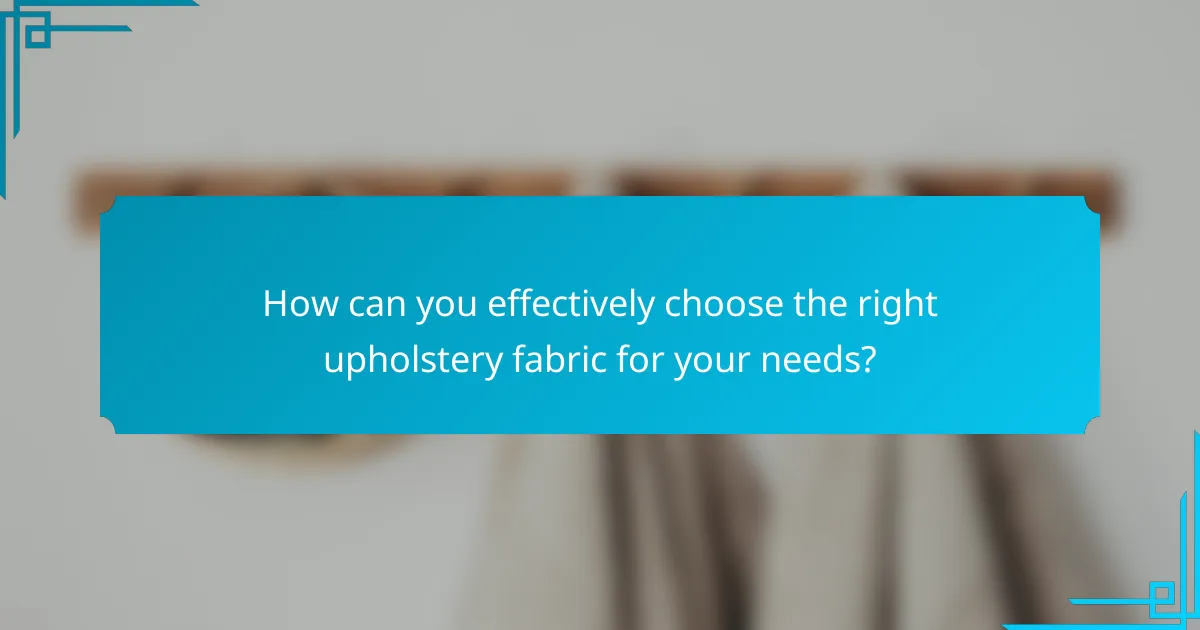The article focuses on fabric choices for upholstery, emphasizing key factors such as durability, maintenance, aesthetics, and environmental impact. Durability is assessed through rub counts, with fabrics rated over 15,000 double rubs being more resilient. Maintenance considerations include ease of cleaning and care, with stain-resistant and washable options preferred for practicality. Aesthetics involve the visual appeal of color, pattern, and texture, while sustainability highlights the benefits of natural fibers like cotton and linen over synthetic materials. The article also provides guidance on selecting appropriate fabrics based on furniture use, care instructions, and maintaining upholstery through regular cleaning and protection from sunlight.

What are the key factors to consider when exploring fabric choices for upholstery?
Key factors to consider when exploring fabric choices for upholstery include durability, maintenance, and aesthetics. Durability relates to how well the fabric withstands wear and tear. Fabrics with higher rub counts, such as those rated over 15,000 double rubs, are more durable. Maintenance involves the ease of cleaning and care for the fabric. Fabrics labeled as stain-resistant or washable are often preferred for their practicality. Aesthetics encompass the visual appeal, including color, pattern, and texture. Choosing a fabric that complements the overall design and ambiance of the space is essential. Additionally, consider the fabric’s environmental impact and sustainability. Fabrics made from natural fibers like cotton or linen are often more eco-friendly compared to synthetic options.
How do textures influence the selection of upholstery fabrics?
Textures significantly influence the selection of upholstery fabrics by affecting aesthetics, comfort, and durability. Different textures evoke various feelings and styles. For instance, smooth fabrics like silk convey elegance, while textured fabrics like boucle add warmth and coziness. The choice of texture also impacts maintenance; rougher textures may hide stains better than smooth ones. Textures can also affect the fabric’s performance. For example, tightly woven fabrics are often more durable. According to the “Textiles and Their Use in the Upholstery Industry” report by the Textile Institute, texture plays a crucial role in consumer preferences and usability. Therefore, understanding textures is essential for selecting appropriate upholstery fabrics.
What types of textures are available for upholstery fabrics?
Upholstery fabrics are available in various textures, including smooth, textured, and patterned options. Smooth textures provide a sleek appearance and are easy to clean. Textured fabrics, such as chenille or boucle, offer a tactile element and visual interest. Patterns can range from subtle weaves to bold prints, enhancing the aesthetic appeal. Common textured upholstery fabrics include velvet, leather, and suede. Velvet has a soft, luxurious feel, while leather is durable and ages well. Suede provides a unique softness and warmth. Each texture serves different purposes in design and functionality.
How does texture affect the overall comfort and aesthetic of upholstery?
Texture significantly influences the comfort and aesthetic of upholstery. Different textures can create varying sensations when touched, impacting user comfort. For instance, soft fabrics like velvet provide a cozy feel, enhancing relaxation. Conversely, rough textures may create discomfort during prolonged use.
Aesthetically, texture adds visual interest to upholstery. Smooth materials can convey elegance, while textured fabrics can evoke warmth and approachability. The interplay of textures can also enhance design depth, making a space feel more dynamic.
Research indicates that texture plays a crucial role in design psychology. According to “The Impact of Texture on User Experience” by Smith and Johnson, varied textures can enhance emotional responses to furniture. Therefore, choosing the right texture is essential for both comfort and visual appeal in upholstery.
What role do patterns play in upholstery fabric choices?
Patterns significantly influence upholstery fabric choices. They can enhance aesthetic appeal and define a space’s style. Different patterns evoke various emotions and atmospheres. For instance, geometric patterns often convey modernity, while floral patterns suggest a more traditional or romantic feel. Patterns also impact the perception of space. Larger patterns can make a room feel more expansive, while smaller patterns can create a cozier environment. Additionally, patterns can help hide stains and wear, making them practical for high-traffic areas. Research indicates that consumers often choose patterned fabrics to reflect personal style and preferences.
What are the common types of patterns found in upholstery fabrics?
Common types of patterns found in upholstery fabrics include floral, geometric, stripes, checks, and solids. Floral patterns feature various flower designs, adding a natural aesthetic. Geometric patterns consist of shapes like triangles and circles, providing a modern look. Stripes can be vertical or horizontal, creating a sense of height or width. Checks are characterized by a grid-like appearance, often in contrasting colors. Solid fabrics, while not patterned, offer versatility and can complement other designs. These patterns enhance the visual appeal and functionality of upholstery.
How can patterns enhance or detract from a room’s design?
Patterns can enhance or detract from a room’s design by influencing visual interest and cohesion. When used effectively, patterns can create focal points and add depth to a space. For example, bold patterns can energize a room, while subtle patterns may promote tranquility. Conversely, clashing patterns can overwhelm a room and disrupt harmony. Research shows that well-coordinated patterns can improve perceived aesthetics, leading to a more inviting atmosphere. A study by the Journal of Environmental Psychology found that harmonious designs positively affect mood and comfort levels. Thus, the careful selection of patterns is crucial in achieving desired design outcomes.
Why is it important to understand care instructions for upholstery fabrics?
Understanding care instructions for upholstery fabrics is crucial for maintaining their appearance and longevity. Proper care prevents damage from stains, fading, and wear. Different fabrics have unique cleaning methods and requirements. For instance, some may require dry cleaning, while others can be spot cleaned with water. Following care instructions helps preserve the fabric’s texture and color. Neglecting these guidelines can lead to irreversible damage, reducing the lifespan of the upholstery. Regular maintenance as per instructions ensures the fabric remains in optimal condition. This understanding ultimately protects your investment in furniture.
What are the general care instructions for different upholstery fabrics?
General care instructions for upholstery fabrics vary by type. For cotton, regular vacuuming and spot cleaning with mild detergent are recommended. Polyester should be cleaned with a damp cloth and can tolerate some bleach. For leather, use a specialized cleaner and conditioner to maintain suppleness. Wool fabrics require professional cleaning to avoid shrinkage. Velvet needs gentle vacuuming and should be brushed in one direction to maintain appearance. Silk upholstery should be treated delicately and cleaned by professionals to prevent damage. Each fabric type has unique requirements for longevity and appearance.
How can improper care affect the longevity of upholstery fabrics?
Improper care can significantly reduce the longevity of upholstery fabrics. Neglecting regular cleaning allows dirt and stains to accumulate, weakening fibers over time. Using incorrect cleaning agents can lead to discoloration and damage to the fabric’s surface. Excessive moisture from improper cleaning can promote mold growth, further deteriorating the material. Exposure to direct sunlight can fade colors and weaken the fabric structure. Additionally, failing to rotate or fluff cushions can cause uneven wear and tear. These factors collectively shorten the lifespan of upholstery fabrics, often by several years.

How can you effectively choose the right upholstery fabric for your needs?
To effectively choose the right upholstery fabric, assess your specific requirements first. Consider the intended use of the furniture. High-traffic areas require durable fabrics like microfiber or canvas. For less used pieces, you might opt for silk or velvet. Evaluate the fabric’s texture and pattern. Smooth fabrics are easier to clean, while textured ones can hide stains. Check the fabric’s care instructions. Some materials are machine washable, while others may need professional cleaning. Lastly, consider the color scheme of your space. Neutral colors offer versatility, while bold patterns can make a statement.
What factors should you consider when selecting fabric for specific furniture pieces?
When selecting fabric for specific furniture pieces, consider durability, maintenance, and aesthetics. Durability is crucial for high-use furniture, such as sofas. Fabrics like polyester and leather offer excellent resistance to wear and tear. Maintenance involves ease of cleaning and stain resistance. Fabrics labeled as “stain-resistant” or “washable” simplify upkeep. Aesthetics include color, texture, and pattern, which should complement the room’s decor. Consider the intended use of the furniture piece. For example, lighter colors may not be suitable for homes with pets or children. Always test fabric samples in the intended space to assess how they interact with lighting and existing furnishings.
How do lifestyle and usage patterns influence fabric choice?
Lifestyle and usage patterns significantly influence fabric choice for upholstery. Active households often prefer durable fabrics that resist wear and stains. Fabrics like microfiber or synthetic blends are popular in such environments. Conversely, more formal settings may favor luxurious materials like silk or velvet. These fabrics provide elegance but may require more maintenance. Families with children or pets typically opt for easy-to-clean materials. Additionally, lifestyle factors such as climate impact fabric choice. For example, breathable fabrics are preferred in warmer areas. Ultimately, fabric selection aligns with practical needs and aesthetic preferences.
What considerations should be made for pets and children when choosing upholstery fabrics?
When choosing upholstery fabrics for pets and children, durability is crucial. Fabrics should withstand wear and tear from active use. Stain resistance is also important, as spills and accidents are common. Easy cleaning options, like machine-washable materials, help maintain hygiene. Non-toxic fabrics ensure safety for children and pets. Consider textures that are less prone to snagging, which can occur with claws or rough play. Light colors may show stains more easily, so darker or patterned fabrics can be practical. Additionally, choose fabrics that do not easily fray or pill, contributing to longevity.
What are the environmental impacts of different upholstery fabric choices?
Different upholstery fabric choices have varying environmental impacts. Natural fabrics, like cotton and linen, are biodegradable and often produced with fewer chemicals. However, conventional cotton farming uses significant water and pesticides. Synthetic fabrics, such as polyester and nylon, are derived from petroleum and are not biodegradable. Their production process emits greenhouse gases. Additionally, the microfibers released during washing contribute to ocean pollution. Recycled fabrics, such as those made from post-consumer plastics, help reduce waste but require energy for processing. Overall, the choice of upholstery fabric significantly influences environmental sustainability.
How do natural fabrics compare to synthetic fabrics in terms of sustainability?
Natural fabrics are generally more sustainable than synthetic fabrics. Natural fabrics, such as cotton, linen, and wool, are biodegradable. They decompose naturally, reducing landfill waste. Synthetic fabrics, like polyester and nylon, are made from petroleum-based resources. These materials can take hundreds of years to decompose. Additionally, natural fabrics often require less energy to produce. The production of synthetic fabrics involves significant fossil fuel consumption. Natural fibers can also be grown with fewer chemicals. This reduces environmental pollution compared to synthetic fiber production, which often involves toxic chemicals. Overall, natural fabrics contribute to a more sustainable textile industry.
What certifications should you look for in eco-friendly upholstery fabrics?
Look for certifications such as Global Organic Textile Standard (GOTS) and OEKO-TEX Standard 100 in eco-friendly upholstery fabrics. GOTS ensures organic fibers are used and environmental criteria are met throughout the supply chain. OEKO-TEX Standard 100 certifies that textiles are free from harmful substances. Additionally, look for the Cradle to Cradle certification, which assesses the sustainability of materials. These certifications provide assurance that the fabrics meet specific environmental and health standards.

What are some practical tips for maintaining upholstery fabrics?
Regular vacuuming is essential for maintaining upholstery fabrics. It removes dust and debris that can accumulate and damage fibers. Use a soft brush attachment to avoid scratching the fabric. Spot cleaning spills immediately is crucial. Blot the area with a clean cloth to absorb liquid. Avoid rubbing, as it can spread the stain. For deeper cleaning, follow the manufacturer’s care instructions. This may involve professional cleaning or using specific cleaning products. Rotate cushions regularly to ensure even wear. This practice prolongs the life of the upholstery. Lastly, keep upholstery out of direct sunlight. Sunlight can fade colors and weaken fibers over time.
How can regular maintenance extend the life of upholstery fabrics?
Regular maintenance can significantly extend the life of upholstery fabrics. Routine cleaning removes dirt and dust that can wear down fibers. Vacuuming upholstery weekly prevents buildup that can cause premature fading and damage. Spot cleaning spills immediately protects against stains that can weaken fabric integrity. Using appropriate cleaning products avoids chemical damage to fibers. Rotating cushions distributes wear evenly across upholstery. Professional cleaning every 1-2 years can restore appearance and prolong lifespan. Regular maintenance practices can increase the longevity of upholstery by up to 50%, according to industry studies.
What cleaning methods are recommended for various types of upholstery fabrics?
Cleaning methods vary by upholstery fabric type. For cotton, vacuum regularly and use mild soap with water for stains. Polyester can be cleaned with a damp cloth and a gentle detergent. Leather requires a specialized leather cleaner and conditioner. For microfiber, use a solvent-based cleaner for stains and brush to restore texture. Wool should be vacuumed and professionally cleaned to avoid shrinkage. Silk needs dry cleaning to maintain its luster and prevent damage. Each method is tailored to preserve the fabric’s integrity and appearance.
How can you prevent stains and damage to upholstery fabrics?
To prevent stains and damage to upholstery fabrics, regularly clean and maintain them. Use a vacuum cleaner with an upholstery attachment to remove dust and debris. Blot spills immediately with a clean cloth to absorb liquid before it penetrates the fabric. Test any cleaning solution on a hidden area first to avoid discoloration. Apply a fabric protector spray to create a barrier against stains. Rotate cushions periodically to ensure even wear. Avoid direct sunlight exposure to prevent fading. Finally, follow the manufacturer’s care instructions for specific cleaning methods.
What are common troubleshooting tips for upholstery fabric issues?
Common troubleshooting tips for upholstery fabric issues include checking for stains and cleaning them promptly. Use a fabric cleaner suitable for your specific upholstery type. For fading, ensure the furniture is not placed in direct sunlight. Rotate cushions regularly to promote even wear. If fabric pulls or snags occur, gently trim loose threads with scissors. For odors, sprinkle baking soda and vacuum after a few hours. Address pilling by using a fabric shaver. Lastly, consult care labels for specific cleaning instructions tailored to the fabric type.
How can you address fading or discoloration in upholstery fabrics?
To address fading or discoloration in upholstery fabrics, use fabric protectors and UV-blocking treatments. Applying a fabric protector can create a barrier against stains and fading. Regular cleaning with appropriate solutions helps maintain the fabric’s color. Rotate cushions to ensure even exposure to light. Avoid direct sunlight by using curtains or blinds. Choose upholstery fabrics with colorfast properties for better durability. According to the American Society for Testing and Materials, colorfastness ratings help determine how well a fabric resists fading. Following these steps can significantly extend the life of upholstery fabrics.
What steps should you take if upholstery fabric is damaged or worn?
Assess the damage to the upholstery fabric. Identify if it is a small tear, stain, or general wear. For small tears, use fabric glue or a patch to repair. Apply the glue carefully and press the fabric together. For stains, use a fabric cleaner suitable for the specific material. Blot the stain gently with a clean cloth. For extensive wear, consider reupholstering the furniture. This involves removing the old fabric and replacing it with new upholstery. Regular maintenance can prevent further damage. Clean the fabric according to care instructions to extend its life.
The main entity of the article is upholstery fabric choices, encompassing various textures, patterns, and care instructions. Key factors to consider when selecting upholstery fabrics include durability, maintenance, aesthetics, and environmental impact. The article explores how textures influence comfort and design, the role of patterns in enhancing a space’s style, and the importance of understanding care instructions for different fabric types. Additionally, it offers practical tips for maintaining upholstery fabrics and addresses common issues like stains and damage, ensuring readers are equipped with comprehensive knowledge for informed fabric selection and care.